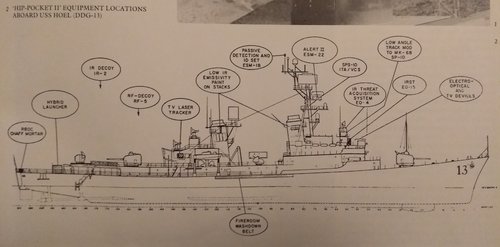A Tentative Fleet Plan
I really should change my personal text
- Joined
- 9 April 2018
- Messages
- 1,068
- Reaction score
- 2,229
From Norman Friedman's US Naval Weapons (1983) p161-162.
Hip Pocket I was authorized on the 30th of August, and evaluated from February-June 1972
The DDG-4 Lawrence was modernised with the following:
Hip Pocket II was authorised in September 1972, and consisted of two separate ships:
DDG-13 Hoel (Pacific) and DLG-9 Coontz (Atlantic)
Hoel was fitted with the following improvements:
Passive defences included special low-emissivity paint, a "fire-room" shield spraying seawater against the ship's side to reduce IR emissions, rapid-bloom chaff (RBOC), an IR Decoy and a variety of laser designators.
Coontz was to test active gun defence, and was fitted Army Vulcan Air Defence Guns (VADS). Gun 1 was operator-controlled, with target range being supplied by sound-powered phone. It was also fitted with a stabilised lead-computing gunsight. Gun 2 however was controlled by a modified Mk-68 Gun Fire Control System. The ship was also fitted with an austere Link 11 NTDS receiver, and a 3-barreled XM-197 20mm gun on a Mk 10 pintle mount.
Of all the Hip Pocket II equipment, only the SPS-10 radar modifications were service approved.
Hip Pocket I was authorized on the 30th of August, and evaluated from February-June 1972
The DDG-4 Lawrence was modernised with the following:
- Chapparel
- Redeye
- an IR Search and Track system
- a CW threat warning radar (sharing the SPS-10 aerial)
- IR shielding for her funnels
- a chaff mortar
- a flamethrower on her fantail (to act as an IR Decoy)
Hip Pocket II was authorised in September 1972, and consisted of two separate ships:
DDG-13 Hoel (Pacific) and DLG-9 Coontz (Atlantic)
Hoel was fitted with the following improvements:
- The ALERT II ESM system (X-Ku Bands), sharing the antenna mount (which antenna is not made clear)
- a Passive Engagement System (PES), which automatically recognised threats and showed their direction in the CIC
- a Shipboard Infrared Surveillance System (SISS)
- a Dual-Spectrum Imaging Sensor (DSIS) for improved targeting detection and identification
- an IR Threat Acquisition and Verification System
- an active-passive range-gated TV camera (with a laser for ranging and dusk/night operation)
- A low-light-level antibloom television
- The SPG-53 (Mk 68 GFCS) was modified for better low-angle tracking.
- The SPS-10 was given an incoming target alarm and video clutter suppression and was to be able to react to threats closing at Mach 0.5-3.0.
Passive defences included special low-emissivity paint, a "fire-room" shield spraying seawater against the ship's side to reduce IR emissions, rapid-bloom chaff (RBOC), an IR Decoy and a variety of laser designators.
Coontz was to test active gun defence, and was fitted Army Vulcan Air Defence Guns (VADS). Gun 1 was operator-controlled, with target range being supplied by sound-powered phone. It was also fitted with a stabilised lead-computing gunsight. Gun 2 however was controlled by a modified Mk-68 Gun Fire Control System. The ship was also fitted with an austere Link 11 NTDS receiver, and a 3-barreled XM-197 20mm gun on a Mk 10 pintle mount.
Of all the Hip Pocket II equipment, only the SPS-10 radar modifications were service approved.
Attachments
Last edited:

